Unlike my quick pickled cabbage, which is on the softer side, this pickled cabbage remains crunchy as it's not exposed to a hot brine. Instead, this cabbage is slowly pickled in a delicious sweet and mildly tangy cold brine over a couple of days in a fridge. It takes a little longer to pickle, but the cabbage retains most of its crunch, stays plump, and tastes fresh. I prefer this variation of pickled cabbage and make it more often than the quick pickled one or fermented cabbage - sauerkraut. It is superbly delicious, almost addictive. It's a great accompaniment to meats and a great addition to various salads.
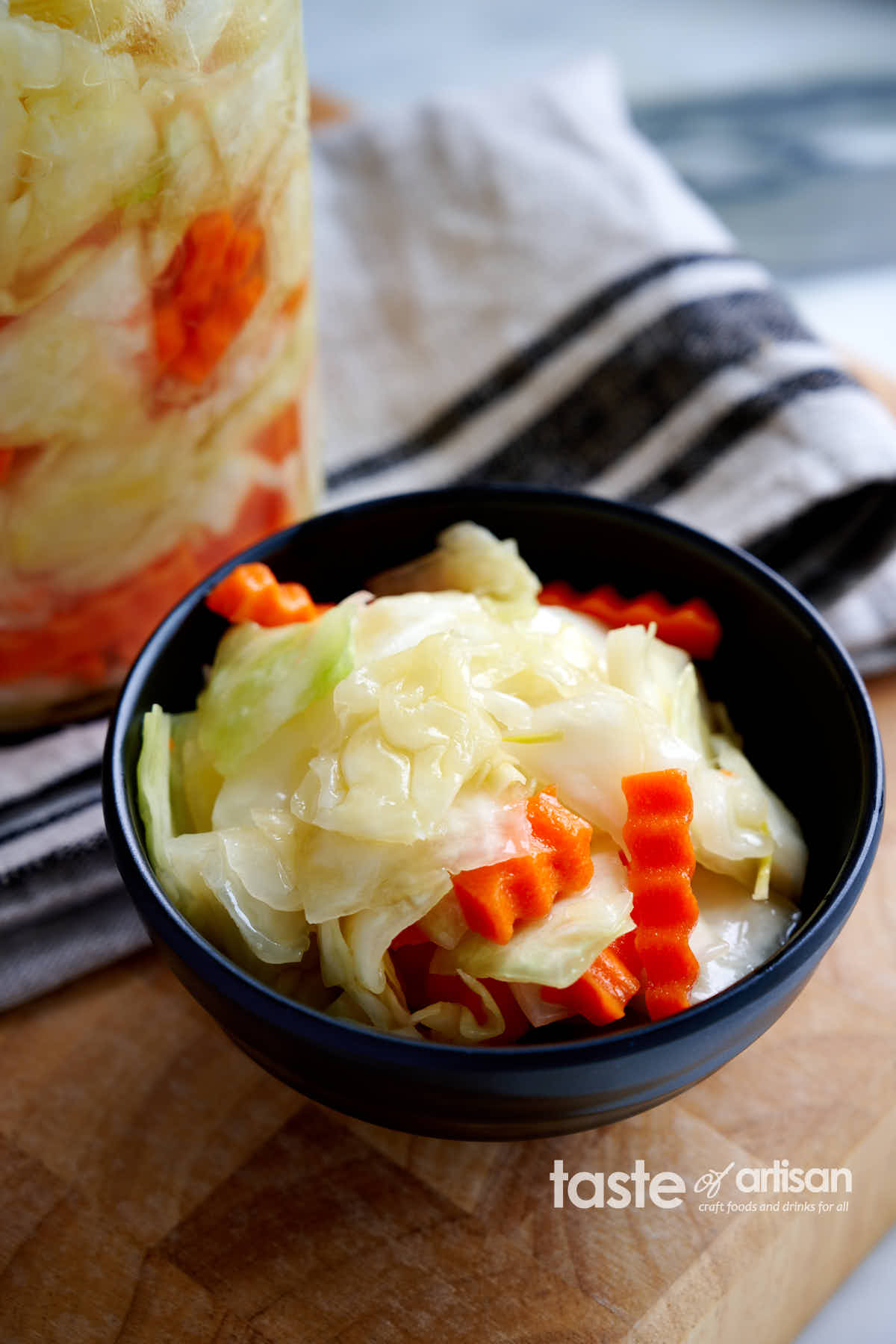
The pickling brine used in this recipe is the secret to making this pickled cabbage irresistibly delicious. It's perfectly sweet and tangy, with a gentle touch of saltiness. It reminds me of Thai food, which emphasizes the perfect balance of sweet, salty, sour, and spicy, except that there is no spicy taste here. You can easily add a spicy component to this recipe if you like spicy food—e.g., a pinch of cayenne pepper or a thinly sliced hot chili pepper.
This recipe was inspired by pickled cabbage from my local Eastern European supermarket. Every time we shop there, which isn't often as it's on the other side of the city, we would get a container or two. The brine the cabbage is in is so delicious that you can literally drink it. I do. I love it. Unfortunately, the cabbage would be gone within 3-4 days. That's always a problem. So, I decided to recreate it at home. Not only would I solve the supply problem, but I would also save quite a bit of money.
Ingredients for this pickled cabbage
There are only a few basic ingredients required for this recipe:
- White cabbage
- Salt
- Carrots
- Fresh garlic
- Frozen cranberries
- Pickling brine
For the pickling brine, you will need:
- Sugar
- Vinegar
- Sunflower oil
- Water
It took me a few tries to recreate the brine recipe. It wasn't too difficult to obtain the same taste initially, but cabbage, during the course of pickling, releases some water. This dilutes the brine, which requires the initial brine to be a touch stronger but not too strong. Just strong enough to become perfect after the pickling is done. But, in the end, I nailed it.
The best cabbage for this recipe is white cabbage. I've tried making this recipe with green cabbage, but it wasn't the same. It lacked the thickness, the beautiful beige color, the crunch, and the sweetness. So, I strongly recommend using white cabbage for pickling.
Making pickled cabbage
Make the brine
Combine the brine ingredients in a bowl and stir with a large spoon or a whisk until the sugar is fully dissolved.
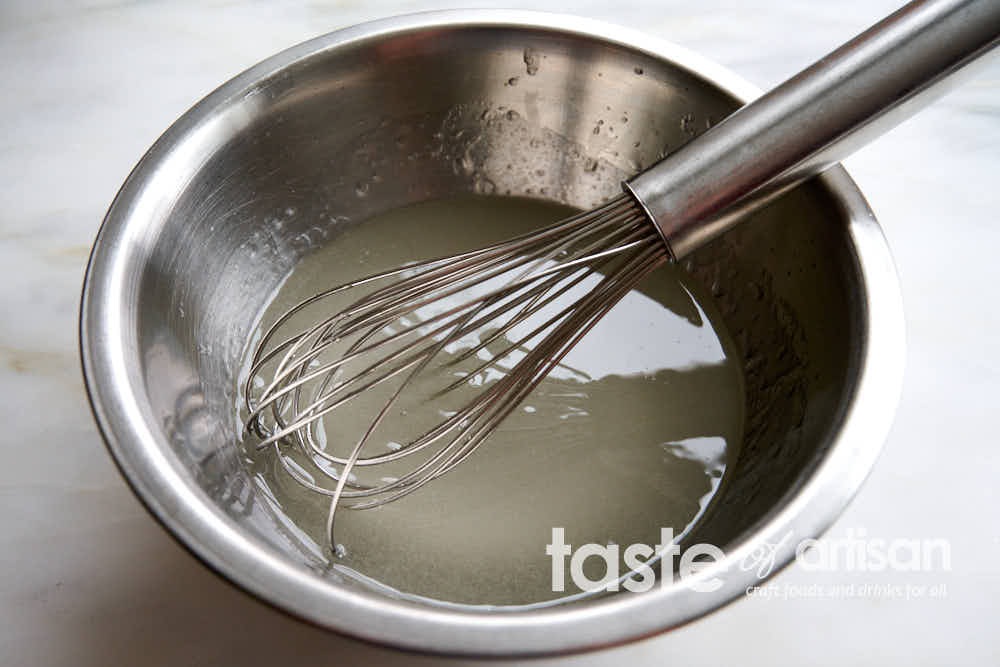
Dicing/shredding
Rinse and dry the cabbage before dicing. I like to cut my cabbage into 1" squares. For some reason, I prefer diced cabbage to shredded in this recipe. But please feel free to shred it if you like; there is no right or wrong here.
Mixing with salt
Next, sprinkle salt over the cabbage and mix well, firmly squeezing the cabbage as you mix. Do that until you notice the cabbage begins to shrink and release juices. It will take about a minute or two.
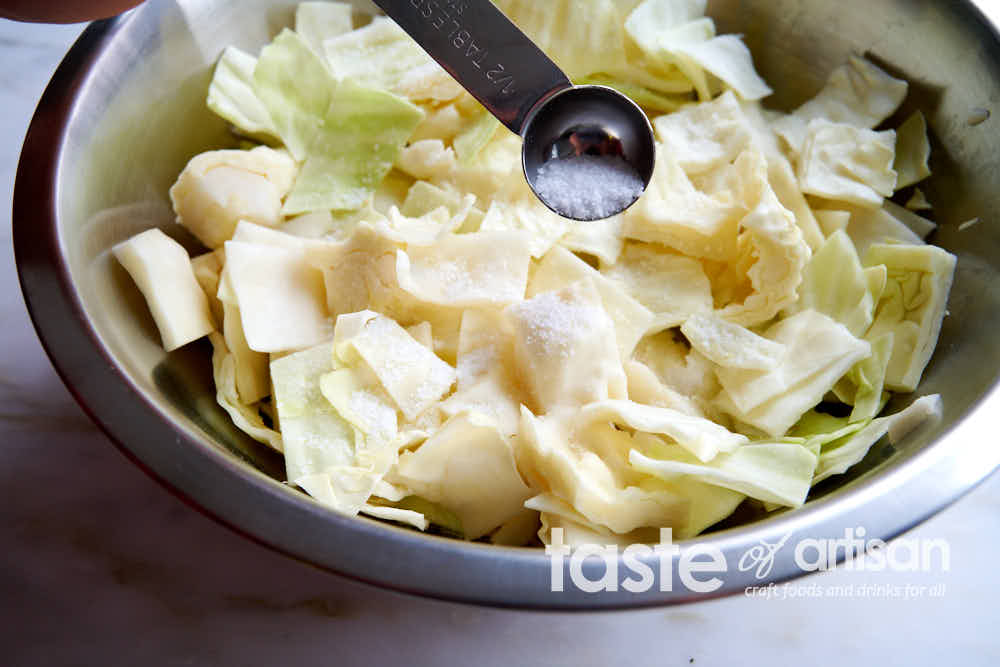
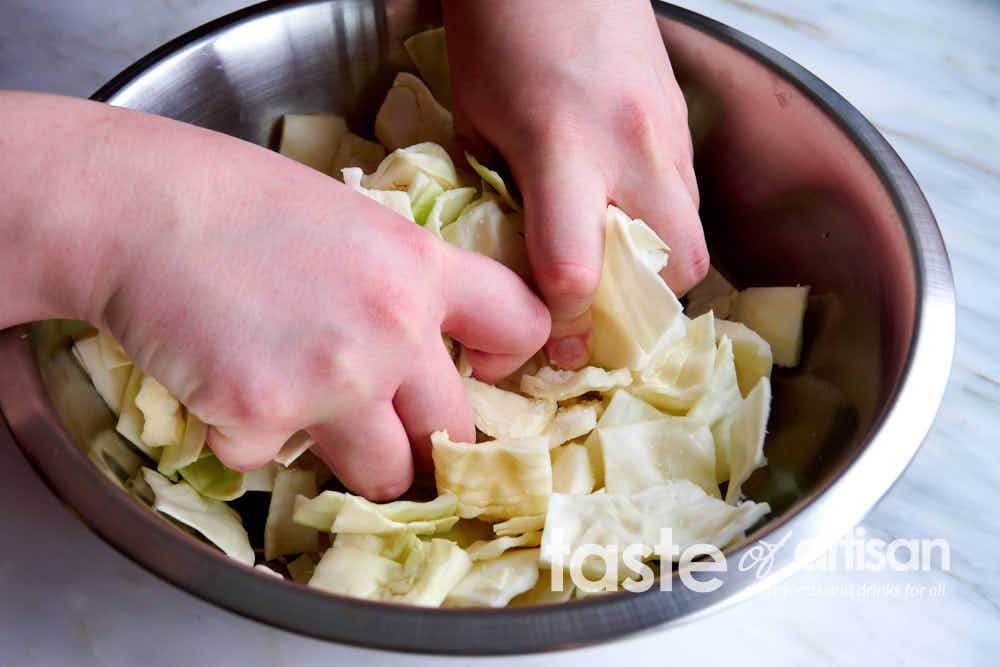
Adding the rest of the ingredients
Next, add the carrots, garlic, and brine, along with the cranberries if using them. Cranberries aren't strictly needed in this recipe, but if you have them on hand, add them. I love the tart bite they add to pickled cabbage. Mix well.
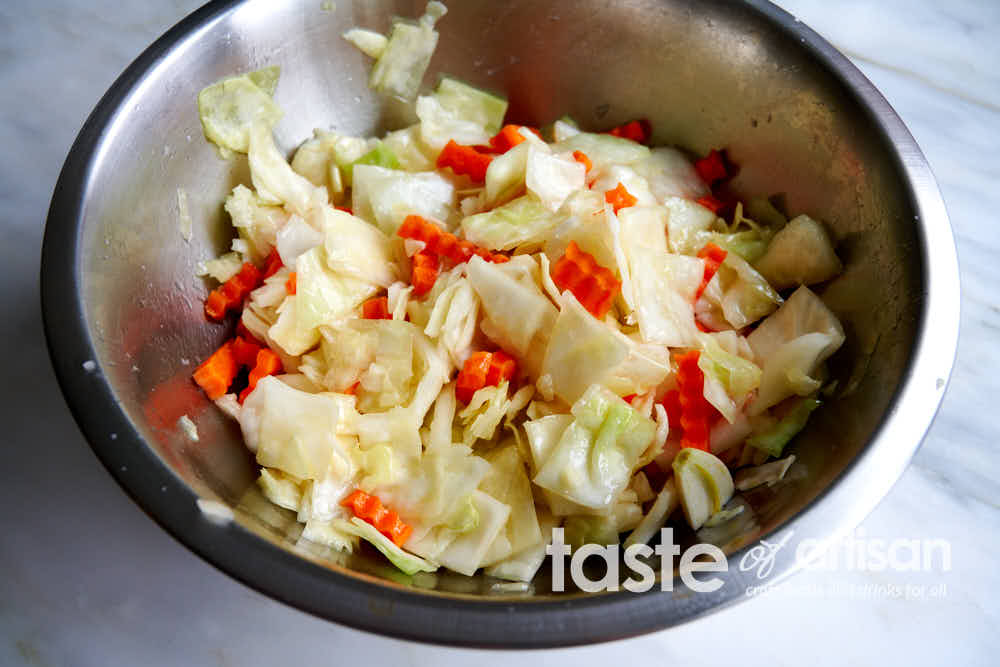
Fill the jar
You will need a jar to pickle your cabbage. I use quart-size Mason jars to make pickled cabbage, as I find them large enough to make a good amount of cabbage but small enough to store in the fridge. Of course, you can use larger or smaller jars, plain Mason jars, or fancy pickling jars.
This step is a little bit tricky. You must pack the cabbage while filling the jar as tightly as possible before topping it with the pickling brine left at the bottom of the mixing bowl. For this step, you can use a cabbage smasher/stomper. If you don't have one, get creative and find something similar in your kitchen. I am sure everyone's kitchen has a utensil or two suitable for completing this task.
I also like using a stainless steel wide-mouth funnel to keep the working area and the jar clean while transferring the cabbage.
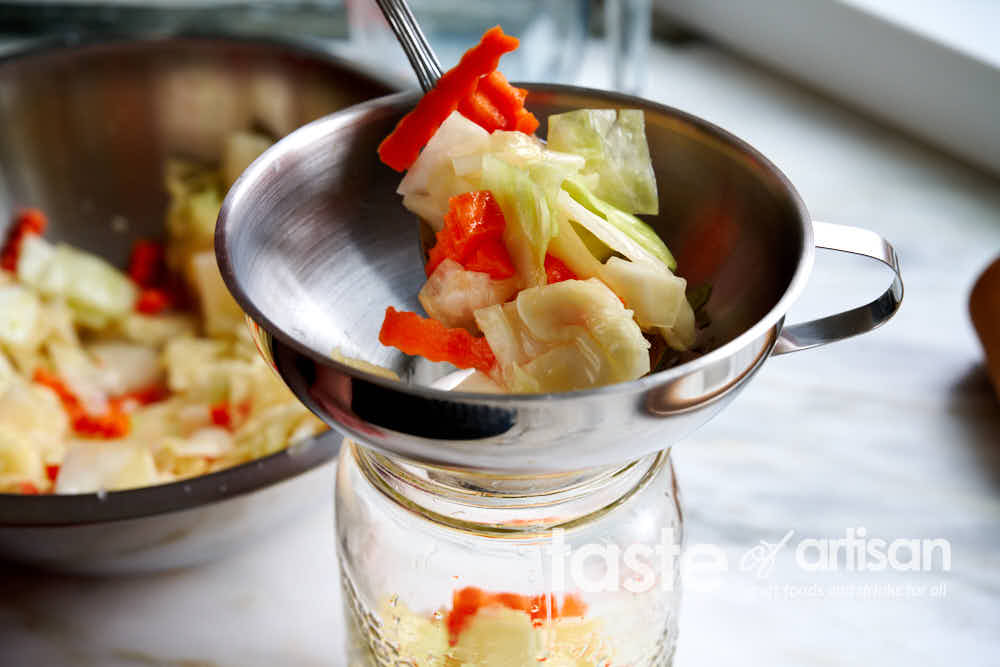
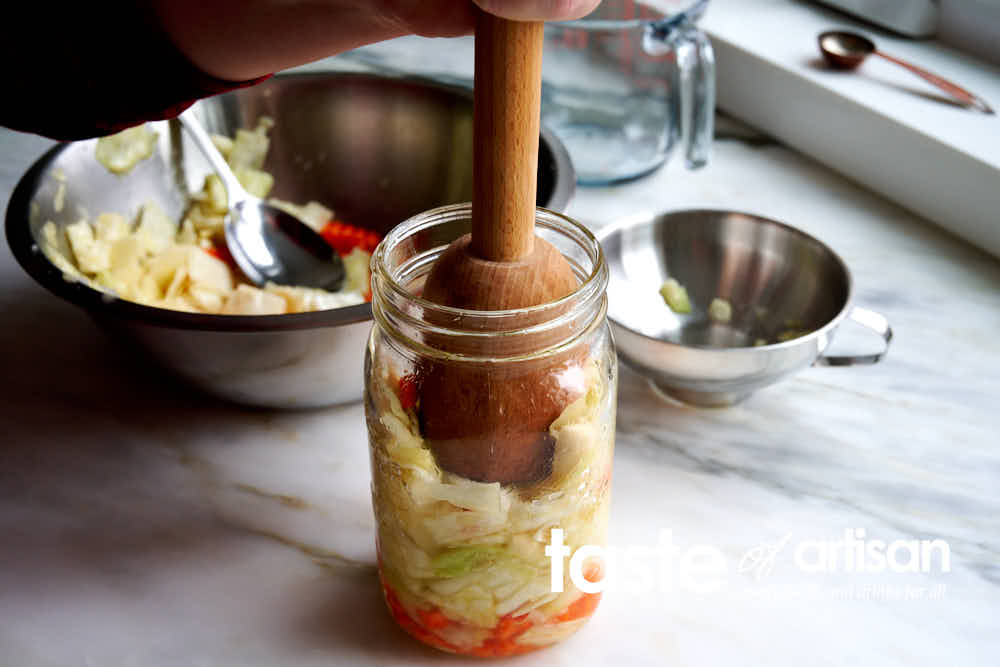
Fill the jar(s) to about 1/2" from the top. Pour the leftover brine into the jar, leaving a 1/4" headspace. Close with a tight lid.
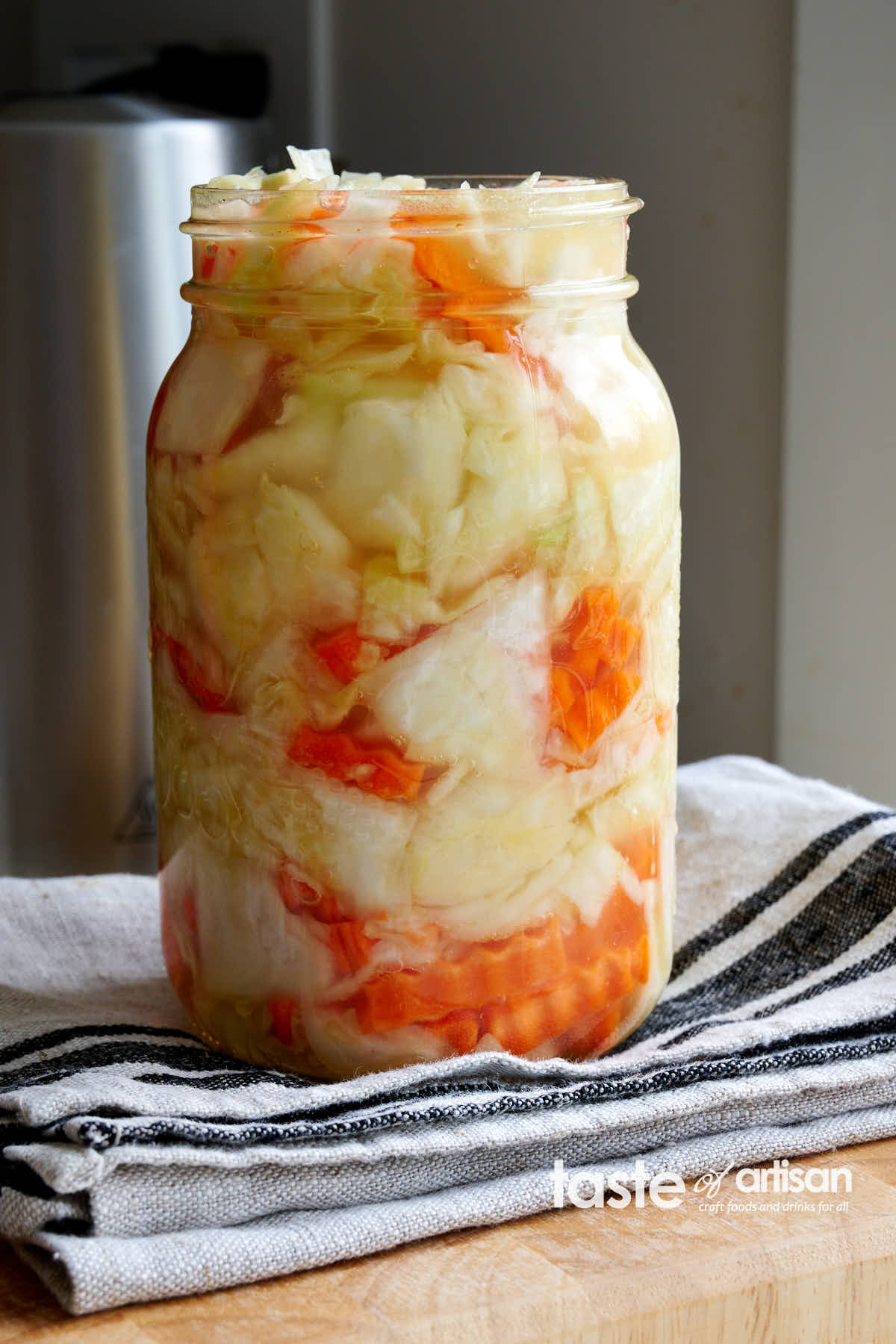
Pickling in the fridge
The final step is to allow the cabbage some time to pickle. You can eat right away, it will taste very good, but after two days in the fridge, it will be fantastic. It only gets better in the fridge and will stay fresh for several weeks or even longer.
Enjoy!
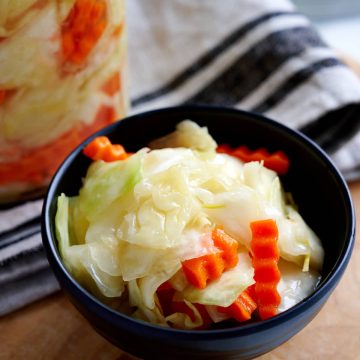
Crunchy Pickled Cabbage (Sweet, Salty, and Tangy)
Ingredients
- 600 g white cabbage approximately 7 cups of diced cabbage
- 13 g kosher salt 1/2 Tbsp (heaping)
- 1 medium carrot approximately 1 cup of carrot chunks
- 2 cloves garlic cut in halves
- 1/4 cup frozen cranberries optional
For the pickling brine
- 160 g water 3/4 cup minus 2 tsp
- 42 g white vinegar 5 Tbsp
- 25 g white sugar 2 Tbsp (heaping)
- 35 g sunflower oil 5 Tbsp
Instructions
- Rinse the cabbage and cut it into 1" squares. Transfer to a medium bowl. Sprinkle the salt over the diced cabbage. Mix well, firmly squeezing the cabbage as you mix. You will notice the cabbage shrink in size and start releasing juices. This will help with packing the cabbage.
- Peel the carrot, rinse, and cut into 2" long and 1/4" - 5/8" thick sticks.
- To prepare the pickling brine, combine the brine ingredients in a separate bowl and stir with a large spoon or a whisk until the sugar is fully dissolved. Set aside.
- Mix the cabbage with the rest of the ingredients, including the brine, in a large bowl.
- Pack the cabbage mix into a quart-size Mason jar tightly. I find that using a cabbage smasher/stomper is very helpful. If you don't have one, use something similar to help with this task. Leave about a 1/2" headspace.
- Top the jar with the remaining pickling brine, leaving a 1/4" headspace. Close tightly with a lid.
- Transfer to the fridge and refrigerate for 2 days before consuming. This cabbage improves with age and will stay fresh in the fridge for several weeks.


Tara says
Hello. What do you mean by cut cabbage into squares?
Victor @ Taste of Artisan says
As shown in the pictures 🙂 Apologies for not being clear, but that's the best way I could describe it.
Barry says
My favorite "sauerkraut" was Rosoff's, sold in refrigerated. It wasn't fermented, it was crispy, a bit sweet and delicious. The company that made Rosoff's was sold in around 2009 and the acquiring company ceased production. Try as I may, I couldn't find a taste-alike for years. I am overjoyed that I stumbled across this recipe.
This recipe gave me a great starting point -- and a METHOD -- and gave me confidence to make a stab at reproducing what I fondly remember. I do apologize for taking some liberties with Victor's recipe.
I shred the cabbage and omit the carrot/garlic/cranberries. Then, I amped the vinegar and sugar, and add some Sour Salts (citric acid). Here are my ingredients in case anyone else has this hankering. I will likely had a knife-point of alum next time to retain crispiness as I do when making pickles.
700g Cabbage, shredded as a slaw
13g Kosher salt
130g White vinegar
75g Water
80g Granulated sugar
5g Citric acid (sour salts)
35g oil
1/8 tsp Alum
BTW, a cocktail muddler is very effective when packing the cabbage.
Victor @ Taste of Artisan says
Thanks for your input, Barry. I will try your version. Thank you!
jen says
What is the sunflower oil for? Not listed in the recipe.
Victor @ Taste of Artisan says
The oil in the pickling brine makes the cabbage taste better IMHO and helps preserve the color of the vegetables. I modified the original recipe and updated the post, I think the new one is a big improvement. Enjoy!
Napassorn says
I don't have a glass jar at home, is there any alternative suggestion for a container?
Thanks from Thailand
Victor @ Taste of Artisan says
Anything will be fine. A bowl will do. Enjoy!!!